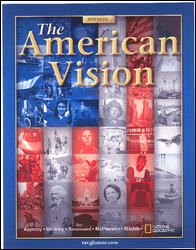

The American VisionChapter 2: Colonizing America, 1519–1733Chapter OverviewsThis chapter focuses on how the Spanish, French, and English founded colonies in North America that reflected their values and traditions. Section 1 explains how the Spanish and French built their American empires. During the early 1500s, Spanish explorers ventured into the area that is now Mexico and Peru. On their quest for gold and enslaved labor, they gained allies, spread disease, and conquered two Native American civilizations. Later Spanish expeditions explored North America's southern and southwestern areas. By the 1600s, the Spanish Catholic Church led the way in settling the Southwest. The people of Spain influenced the colonies' governing system, structured societies, and impact on Native Americans. The French took a different approach to colonization. French merchants, attracted by the lucrative fur market, established New France in what is today Nova Scotia. French fur traders and Jesuit missionaries commonly lived among the Native Americans and learned their culture. When France's king grew unhappy with the colony's slow growth, he took actions to expand its population and borders. As a result of one expedition, France gained a vast territory named Louisiana. Section 2 details how religious, economic, and political changes in England led the English to establish colonies in North America. By the late 1500s, new ideas swept through Europe that changed both religion and politics. These changes also affected what the English thought about colonization. Puritans looked for a place to practice their beliefs, England's poor and unemployed searched for new opportunities, and merchants needed to expand markets. As the rivalry with Spain intensified, English leaders pushed to establish outposts in America. The first colony, Roanoke, vanished mysteriously, and the second colony, Jamestown, was plagued with problems from its inception. Nearly abandoned, Jamestown found economic salvation in tobacco. Another English colony, Maryland, was founded to assure Catholics the freedom to practice their religion. Section 3 describes the founding of the New England colonies. Escaping religious persecution at home, Puritans sailed to America in 1620 and established the Plymouth colony in New England. More Puritans arrived in America when the Massachusetts Bay Company offered thousands of Puritans the opportunity for a new life. Since Puritan beliefs guided the government of Massachusetts, those who disagreed with Puritan ideas could be banished from the colony. Some who felt restricted in Massachusetts decided to establish more tolerant New England communities. Rhode Island's charter emphasized religious freedom with total separation of church and state. Connecticut offered a written constitution that granted all adult men the right to vote. To the north, settlers established the colonies of New Hampshire and Maine. After a war with Native Americans, English settlers gained complete control of New England. Section 4 discusses the Middle and Southern colonies that were founded along the Atlantic seaboard. After the English Civil War, England's monarchy and interest in colonization were restored. England's first move was to seize the successful Dutch colony of New Netherlands, now called New York. A portion of the territory became the New Jersey colony. The king granted Quaker William Penn a charter to found Pennsylvania. Penn's aim was to establish a colony where complete political and religious freedom could be practiced. Part of Penn's territory was land that later became the colony of Delaware. Friends and political allies of the king were granted land that became the Southern colonies of North Carolina, South Carolina, and Georgia. By 1770, England had built a large and prosperous society of settlers attracted by the opportunity to practice religious freedom and to prosper under new forms of government. |  |















